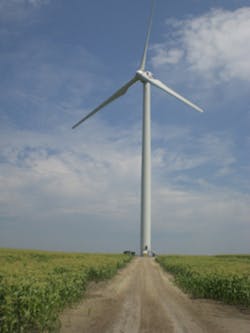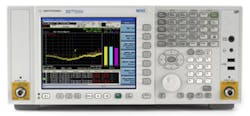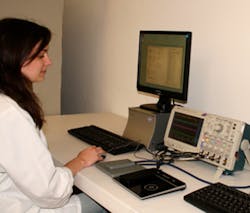The 2013 IEEE International Symposium on Electromagnetic Compatibility will take place Aug. 5-9 in Denver. The event promises numerous presentations and exhibits focused on the role of test and measurement in ensuring compatibility.
Indeed, the symposium kicks off Monday morning with a presentation titled “Basic EMC Measurements” by Andy Marvin of the University of York. He will describe the basic philosophy behind common EMC measurement techniques and cover both conducted and radiated measurements.
Several Friday presentations will continue the basic-measurement theme. They include “IEC Approach to Immunity Test Methods Using the Application of Continuous RF Disturbances” by John Maas, IBM; “IEC View of Transient Immunity Testing” by Thomas E. Braxton, Braxton EMC Consulting; and “Immunity Measurement Test Facilities and Instrumentation” by Don Heirman, Don Heirman Consultants, and Bill Radasky, Metatech.
A full-day tutorial on Monday is titled “Measurement Uncertainty—Challenges and Solutions.” Presentations will include “Overview of EMC Measurement Uncertainty for the Novice and Veteran Engineer—Why These Measurements Are Important, But Often Overlooked” by Ray Adams, Boeing; “Everyday, Practical Tools for Measurement Uncertainty Evaluation in a Lab Environment” by Dennis Lewis, Boeing; “On Whether Variation in the Uniform Field Area Should be Included in Calculation of Uncertainty for 61000-4-3” by Carlo F. M. Carobbi, the University of Florence; “Simplifying the Complexity of Making a Good Measurement Uncertainty Calculation: A Review of Numerical Studies” by Vince Rodriguez, ETS-Lindgren; and “Calculating and Use of Measurement Uncertainty from the Perspective of an Independent, Accredited EMC Lab” by Per Thåstrup Jensen, Delta.
EMC and the Smart Grid
Also of interest will be a Monday half-day tutorial titled “Low-Frequency EMC within the Smart Grid Including Interference Between Equipment for Renewables and Smart Meters.” Presentations will include “Experiences from Field Measurements” by Frank Leferink, the University of Twente; “Interference Related to Electronic Equipment Including Smart Metering and LEDs” by Math Bollen, Luleå University of Technology; “Lower Frequency Phenomena in Smart Grids” by Jaroslaw Luszcs, the University of Zielona Góra; “Influence of Conducted EMI on Transmission Systems and Novel Filtration Methods for Power Electronics in Smart Grids” by Robert Smolenski, the University of Zielona Góra; and “Standardization Progress in the Range of 2 kHz to 150 kHz” by Theo Laughner, the Tennessee Valley Authority.
A Monday afternoon tutorial will address recent developments in EMC for emerging wireless technologies. Test-related presentations in this tutorial include “Radiated Two-Stage Method for MIMO Throughput Test—An Ideal Way for Both Certification and R&D” by Yangguang Xu, Tri-L Solutions; “Wireless Testing Using a Reverberation Chamber” by Chris Holloway, NIST; “A Personal Test Environment for Every Wireless Engineer—An Innovative Multi-Purpose Compact Anechoic Chamber” by Kefeng Liu, Tri-L Solutions; and “Real-World Over-The-Air Performance Measurements of Wireless Devices” by Garth D’Abreu, ETS-Lindgren.
A Monday half-day tutorial titled “EMC Consultant’s Toolkit” also will incorporate a test-related presentation: “Acquiring Test Equipment and Developing a Low-Cost EMC Troubleshooting Kit” by Patrick André, André Consulting, and Kenneth Wyatt, Wyatt Technical Services.
Friday afternoon will feature a half-day tutorial on reverberation chambers (RC). Presentations will include an introduction by Vignesh Rajamani of Oklahoma State University followed by “Models for Antennas in Reverberation Chambers” by John Ladbury, NIST; “Characterization of EM Environments using RC Techniques” by Chuck Bunting, Oklahoma State University; “Measuring Intrinsic Material Shielding Effectiveness Using Coupled Reverberant Cavities” by Greg Tait, the Naval Surface Warfare Center; “Antenna Performance Evaluation in Reverberation Chambers” by Dennis Lewis, Boeing; and “Wireless Device Testing in Reverberation Chambers” by Garth D’Abreu, ETS-Lindgren.
In addition, a Friday afternoon tutorial on EMC in 3-D chip integration will provide two test-related presentations: “Eye-Diagram Simulation of a High-Speed TSV Channel” by Heegon Kim, Jonghyun Cho, Kiyeong Kim, Manho Lee, and Joungho Kim, the Korea Advanced Institute of Science and Technology; and “Correlation of Simulation with Measurement for PDN Impedance and SSO Noise in 3D-SiP” by T. Sudo and Shohei Kawaguchi, the Shibaura Institute of Technology.
Special Sessions
Special sessions throughout the week also will address test topics. One, for example, will offer six papers on spectrum analysis, including “Spectrum Analysis and Measurements in a Congested Electromagnetic Environment” by Randy Jost, Ball Aerospace and Technologies; “Electromagnetic Interference to Radar Receivers Due to In-Band OFDM Communications Systems” by Brian Cordill and Sarah Seguin, The University of Kansas, and Larry Cohen, the Naval Research Laboratory; “Spectrum Occupancy Measurements at Three Locations” by Chriss Hammerschmidt, the Institute for Telecommunication Sciences; “Processing Techniques for Spectrum Surveys” by Heather Ottke, the Institute for Telecommunication Sciences; “Transmitter-in-the-Loop Optimization of Physical Radiated Radar Emissions” by Sarah Seguin, John Jakabosky, and Shannon Blunt, the University of Kansas; and “Conducted and Radiated Measurements of an Ultrawideband Surveillance Radar” by Bob Johnk, the Institute for Telecommunication Sciences.
This year’s symposium will continue the Global EMC and Signal Integrity University program, which provides attendees with approximately 18 hours of instruction plus continuing education credits. Test-related presentations include “High-Speed Serial Links” by Stephen Mueller, Teledyne LeCroy, and “Just How Good is Your SI Simulator?” by Heidi Barnes, Agilent Technologies. Additional presentations will address high-speed probing: Larry Jacobs of Teledyne LeCroy will focus on active probes, Don DeGroot of CCN Labs will cover VNA and TDR probes, and Chris Loberg of Tektronix will discuss passive probes.
Test and Measurement Exhibits
In addition to technical presentations, EMC2013 will have test-related exhibits from companies including Advanced Test Equipment Rentals, A.H. Systems, AE Techron, Com-Power, CST, Cuming Lehman Chambers, ETS-Lindgren, Fischer Custom Communications, Gauss Instruments, Haefely EMC, Intertek, MET Laboratories, Ophir RF, Rohde & Schwarz, Teseq, and Thermo Fisher Scientific.
Some vendors have hinted at what they will have on display. AMETEK EM TEST, for example, will likely feature its automotive and immunity test simulators. AR RF/Microwave Instrumentation plans to feature its full lineup of antennas, amplifiers, conducted immunity test systems, multitone testers, field analyzers, and receivers as well as integrated test systems.
TÜV Rheinland has indicated it will highlight the testing capabilities of its five testing facilities in North America, emphasizing how it can help its clients get their products to market quickly. Customers can choose from EMC labs equipped with 5-meter and 10-meter chambers to handle products of varying sizes from many industries including IT, wireless, industrial, medical, and renewable energy. Mobile EMC labs can test at the customer’s location (Figure 1). All TÜV Rheinland’s EMC labs are ISO/IEC 17025:2005-accredited, FCC-listed, VCCI (the Japanese Voluntary Control Council for Interference by Information Technology Equipment)-registered, and IC (Industry Canada)-recognized, and its Pleasanton, CA, lab carries both Wi-Fi and ZigBee accreditations.
Figure 1. EMC Testing of a Wind Turbine
Courtesy of TÜV Rheinland
In addition, TÜV Rheinland of North America is accredited by OSHA and Standards Council of Canada. It can provide inverter/converter testing and certification services for the United States, Canada, and Europe and assist with local grid connection requirements. TÜV Rheinland’s International Approvals team assists with EMC requirements worldwide.1
For its part, Agilent Technologies said it will exhibit the N9038A MXE EMI receiver (Figure 2), which is compliant to both CISPR 16-1-1 and MIL-STD-461. It enhances compliance testing with measurement accuracy of ±0.75 dB at 1 GHz, high sensitivity with a DANL of -167 dBm at 1 GHz, and a frequency range of 20 Hz up to 26.5 GHz. The MXE includes Agilent X-Series signal-analysis and graphical measurement tools for examining signal details. You also can perform precompliance measurements with the N/W6141A EMI measurement application and any of the X-Series signal analyzers.
Figure 2. N9038A MXE EMI Receiver
Courtesy of Agilent Technologies
D.L.S. Electronic Systems has said it will highlight its capability to offer the Qi compliance mark (Figure 3) under authority from the Wireless Power Consortium for wireless charging applications. D.L.S. offers a global compliance package that, in addition to the formal Qi certification, includes interoperability test, wireless transmitter, and receiver testing under FCC Part 15 and FCC Part 18 for North America and the EMC and R&TTE Directives for the European Union and product safety testing and certification for North America and Europe.
Figure 3. Qi Compliance Testing
Courtesy of D.L.S. Electronic Systems
D.L.S. reported that the recent introduction of inductive wireless chargers and power pads has created some misunderstanding and misapplication of EMC and product safety regulations. How these regulations apply to these devices depends on how the devices operate at various frequencies and whether or not there is any wireless communications present. The company advises that care must be taken to ensure that the correct regulations and testing are applied.
Reference
Nelson, R., “TÜV Rheinland Helps Customers Reach Global Markets,” EE-Evaluation Engineering,
July 2013, p. 32.



